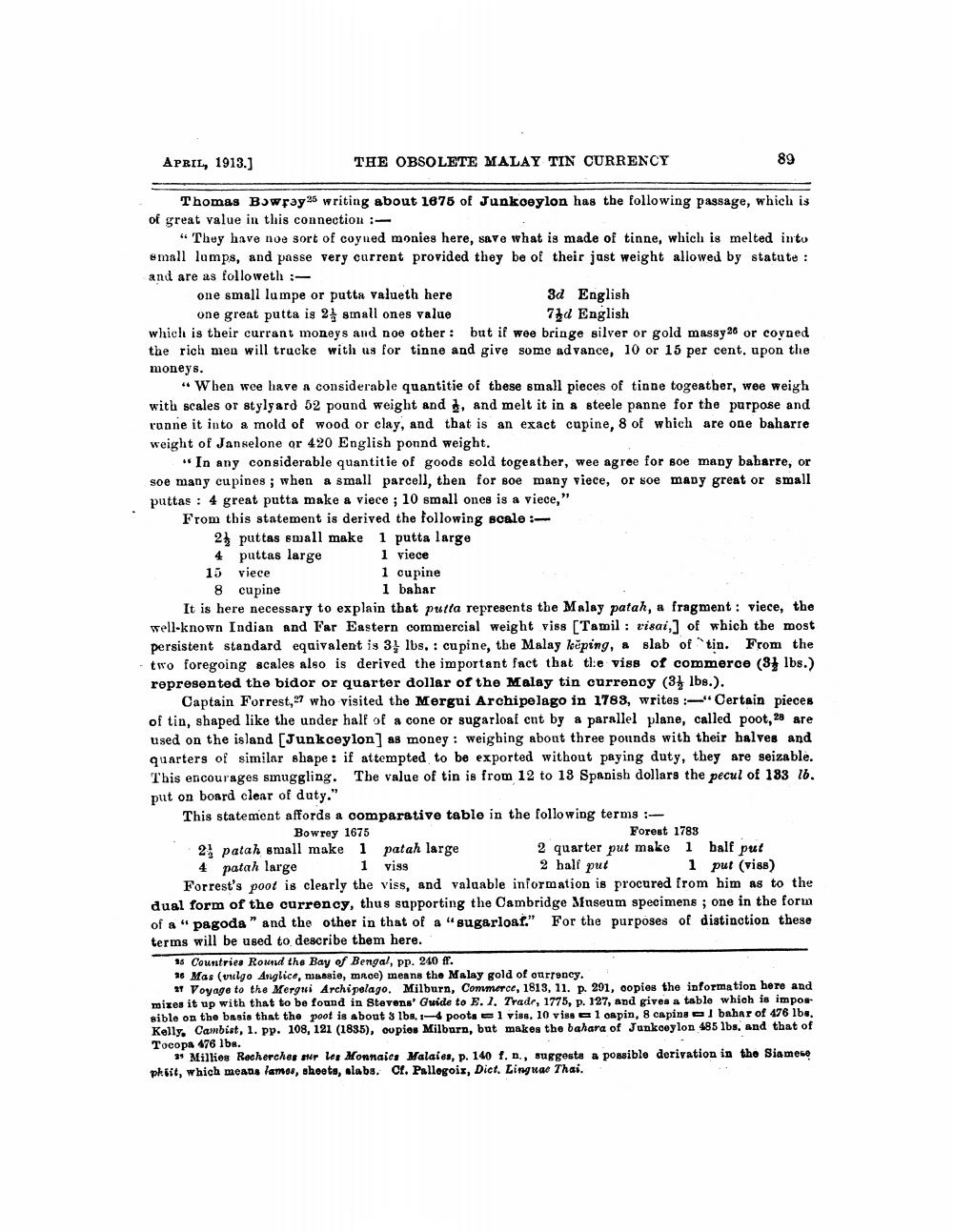________________
APRIL, 1913.]
THE OBSOLETE MALAY TIN CURRENCY
Thomas Bowray25 writing about 1675 of Junkceylon has the following passage, which is of great value in this connection:
"They have noe sort of coyned monies here, save what is made of tinne, which is melted into small lumps, and passe very current provided they be of their just weight allowed by statute: and are as followeth :
89
3d English 7d English
one small lumpe or putta valueth here one great putta is 2 small ones value which is their currant moneys and noe other: but if wee bringe silver or gold massy26 or coyned the rich men will trucke with us for tinne and give some advance, 10 or 15 per cent, upon the moneys.
"When wee have a considerable quantitie of these small pieces of tinne togeather, wee weigh with scales or stylyard 52 pound weight and, and melt it in a steele panne for the purpose and ranne it into a mold of wood or clay, and that is an exact cupine, 8 of which are one baharre weight of Janselone or 420 English ponnd weight.
"In any considerable quantitie of goods sold togeather, wee agree for soe many baharre, or soe many cupines; when a small parcell, then for soe many viece, or soe many great or small puttas 4 great putta make a viece; 10 small ones is a viece,"
From this statement is derived the following scale :
2 puttas small make 1 putta large
4 puttas large
1 viece
15
viece
1 cupine 1 bahar
8 cupine
It is here necessary to explain that putta represents the Malay patah, a fragment: viece, the well-known Indian and Far Eastern commercial weight viss [Tamil: visai,] of which the most persistent standard equivalent is 3 lbs. : cupine, the Malay keping, a slab of tin. From the two foregoing scales also is derived the important fact that the viss of commerce (3 lbs.) represented the bidor or quarter dollar of the Malay tin currency (3 lbs.).
Captain Forrest,27 who visited the Mergui Archipelago in 1783, writes:-"Certain pieces of tin, shaped like the under half of a cone or sugarloaf cut by a parallel plane, called poot, 28 are used on the island [Junkceylon] as money: weighing about three pounds with their halves and quarters of similar shape: if attempted to be exported without paying duty, they are seizable. This encourages smuggling. The value of tin is from 12 to 18 Spanish dollars the pecul of 183 lb. put on board clear of duty."
This statement affords a comparative table in the following terms :
Forest 1788
2 quarter put make 1 half put 2 half put 1 put (viss) Forrest's poot is clearly the viss, and valuable information is procured from him as to the dual form of the currency, thus supporting the Cambridge Museum specimens; one in the form of a "pagoda" and the other in that of a "sugarloaf." For the purposes of distinction these terms will be used to describe them here.
Bowrey 1675
2 patah small make 1 patah large 4 patah large
1 viss
15 Countries Round the Bay of Bengal, pp. 240 ff.
26 Mas (vulgo Anglice, massie, mace) means the Malay gold of ourrency.
27 Voyage to the Mergui Archipelago. Milburn, Commerce, 1813, 11. p. 291, oopies the information here and mixes it up with that to be found in Stevens' Guide to E. 1. Trade, 1775, p. 127, and gives a table which is impossible on the basis that the poot is about 3 lbs. 1-4 poots 1 viss, 10 viss 1 oapin, 8 capins 1 bahar of 476 lbs. Kelly, Cambist, 1. pp. 108, 121 (1835), copies Milburn, but makes the bahara of Junkceylon 485 lbs. and that of Tocopa 476 lbs.
25 Millies Recherches sur les Monnaies Malaies, p. 140 f. n., suggests a possible derivation in the Siamese phiit, which means lames, sheets, slabs. Cf. Pallegoix, Dict. Linguae Thai.




